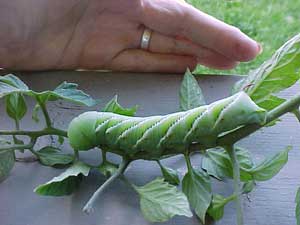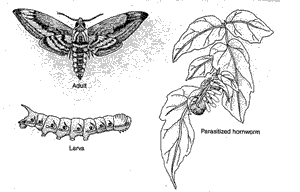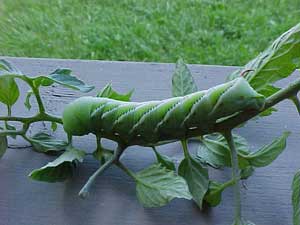 |
Tomato hornworms (Manduca quinquemaculata) are about the biggest caterpillars you’ll see in your landscape. They will startle you when you first spot them munching on your tomato plant. They are all green, 3 to 5 inches long, with diagonal white stripes along the sides, and a fierce-looking but entirely harmless horn projecting from the rear end. These caterpillars feed ravenously on leaves and fruits of tomatoes and related plants.
Adults are large, fast-flying moths, commonly called hawk moths or hummingbird moths. They are mottled gray or brownish, with two rows of 5 orange spots on the stout body. The wingspan is 4 to 5 inches. The moths should appear in June in most areas. Watch for them at dusk, when they hover like hummingbirds near tubular flowers such as petunias or nicotiana, from which they sip nectar with their long tongues.
 |
Hornworm Growth Stages
The moths lay pearl-like, greenish yellow eggs one at a time on the undersides of leaves. The eggs hatch within a week, and the larvae grow to the full size of 3 to 5 inches in about a month. They feed for about a month in the summer and then leave the plants and burrow 3 to 4 inches underground and spend the winter as pupae in hard, brown 2-inch spindle-shaped cases that have a projection like a pitcher handle sticking out from the front. You may notice the pupae when you work the soil in the fall or spring. The moth occurs throughout the United States. There is usually 1 generation per year in the North and 2 or more in South.
Hornworm Symptoms
Tomato hornworms eat holes in the leaves or sometimes whole leaves leaving no stems. Sometimes they chew on fruit of tomatoes and eggplants leaving pretty good sized holes. In a very short period of time, the hornworms can defoliate a small plant. Don't panic if you see just a few of these caterpillars on your plants. A few hornworms cause little damage and are food for the birds. When you notice more than just a few chunks out of the leaves or leaves missing from a plant, then you probably have enough tomato hornworms to take some action.
 |
Plants Affected - Most Common Targets:
Dill (Anethum graveolens)
Eggplant (Solanum Melongena var. esculentum)
Peppers (Capsicum annuum)
Potatoes (Solanum tuberosum)
Tomatoes (Lycopersicon)

